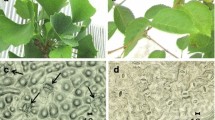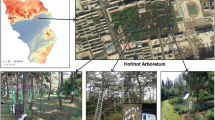Abstract
Leaf wetness provides a wide range of benefits not only to leaves, but also to ecosystems and communities. It regulates canopy eco-hydrological processes and drives spatial differences in hydrological flux. In spite of these functions, little remains known about the spatial distribution of leaf wetness under different soil water conditions. Leaf wetness measurements at the top (180 cm), middle (135 cm), and bottom (85 cm) of the canopy positions of rainfed jujube (Ziziphus jujuba Mill.) in the Chinese loess hilly region were obtained along with meteorological and soil water conditions during the growing seasons in 2019 and 2020. Under soil water non-deficit condition, the frequency of occurrence of leaf wetness was 5.45% higher at the top than at the middle and bottom of the canopy positions. The frequency of occurrence of leaf wetness at the top, middle and bottom of the canopy positions was over 80% at 17:00‒18:00 (LST). However, the occurrence of leaf wetness at the top was earlier than those at the middle and bottom of the canopy positions. Correspondingly, leaf drying at the top was also latter than those at the middle and bottom of the canopy positions. Leaf wetness duration at the middle was similar to that at the bottom of the canopy position, but about 1.46–3.01 h less than that at the top. Under soil water deficit condition, the frequency of occurrence of leaf wetness (4.92%–45.45%) followed the order of top>middle>bottom of the canopy position. As the onset of leaf wetness was delayed, the onset of wet leaf drying was advanced and the leaf wetness duration was shortened. Leaf wetness duration at the top was linearly related (R2>0.70) to those at the middle and bottom of the canopy positions under different soil water conditions. In conclusion, the hydrological processes at canopy surfaces of rainfed jujube depended on the position of leaves, thus adjusting canopy structure to redistribute hydrological process is a way to meet the water need of jujube.
Similar content being viewed by others
References
Aguirre-Gutierrez C A, Holwerda F, Goldsmit G R, et al. 2019. The importance of dew in the water balance of a continental semiarid grassland. Journal of Arid Environments, 168: 26–35.
Aparecido L M T, Miller G R, Cahill A T, et al. 2016. Comparison of tree transpiration under wet and dry canopy conditions in a Costa Rican premontane tropical forest. Hydrological Processes, 30(26): 5000–5011.
Bassimba D D, Intrigliolo D S, Dalla M A, et al. 2017. Leaf wetness duration in irrigated citrus orchards in the Mediterranean climate conditions. Agricultural and Forest Meteorology, 234: 182–195.
Burkhardt J, Basi S, Pariyar S, et al. 2012. Stomatal penetration by aqueous solutions-an update involving leaf surface particles. New Phytologist, 196(3): 774–787.
Batzer J C, Gleason M L, Taylor S E, et al. 2008. Spatial heterogeneity of leaf wetness duration in apple trees and its influence on performance of a warning system for sooty blotch and flyspeck. Plant Disease, 92(1): 164–170.
Berry Z C, Emery N C, Gotsch S G, et al. 2018. Foliar water uptake: processes, pathways, and integration into plant water budgets. Plant, Cell and Environment, 42: 1–14.
Beysens D. 1995. The formation of dew. Atmospheric Research, 39(1): 215–237.
Binks O, Finnigan J, Coughlin I, et al. 2021. Canopy wetness in the eastern Amazon. Agricultural and Forest Meteorology, 297: 108250, doi: {rs 10.1016/j.agrformet.2020.108250 DOI}.
Brewer C A, Smith W K. 1997. Patterns of leaf surface wetness for montane and subalpine plants. Plant, Cell and Environment, 20(1): 1–11.
Chen D Y, Wang Y K, Liu S Y, et al. 2014. Response of relative sap flow to meteorological factors under different soil moisture conditions in rainfed jujube (Ziziphus jujuba Mill.) plantations in semiarid Northwest China. Agricultural Water Management, 136(2): 23–33.
Chen D Y, Wang X, Liu S Y, et al. 2015. Using Bayesian analysis to compare the performance of three evapotranspiration models for rainfed jujube (Ziziphus jujuba Mill.) plantations in the Loess Plateau. Agricultural Water Management, 159: 341–357.
Chen D Y, Wang Y K, Wang X, et al. 2016. Effects of branch removal on water use of rain-fed jujube (Ziziphus jujuba Mill.) plantations in Chinese semiarid Loess Plateau region. Agricultural Water Management, 178: 258–270.
Chen D Y, Hsu K, Duan X W, et al. 2020. Bayesian analysis of jujube canopy transpiration models: Does embedding the key environmental factor in Jarvis canopy resistance sub-model always associate with improving transpiration modeling?. Agricultural Water Management, 234: 106112, doi: {rs 10.1016/j.agwat.2020.106112 DOI}.
Dalla Marta A, Orlandini S. 2010. Analysis of leaf wetness duration dynamics on a sunflower (Heliantus annuus L.) canopy. Physics and Chemistry of the Earth, 35(1-2): 31–34.
Dawson T E, Goldsmith G R. 2018. The value of wet leaves. New Phytologist, 219(4): 1156–1169.
Feng T J, Zhang L, Chen Q, et al. 2021. Dew formation reduction in global warming experiments and the potential consequences. Journal of Hydrology, 593: 125819, doi: {rs 10.1016/j.jhydrol.2020.125819 DOI}.
Fernandez V, Eichert T. 2009. Uptake of hydrophilic solutes through plant leaves: current state of knowledge and perspectives of foliar fertilization. Critical Reviews in Plant Sciences, 28(1-2): 36–68.
Gao Z Y, Shi W J, Wang X, et al. 2020a. Comparison the performance of leaf wetness duration models for rainfed jujube (Ziziphus jujuba Mill.) plantations in the loess hilly region of China using machine learning. Ecohydrology, 13(7): e2237, doi: {rs 10.1002/eco.2237 DOI}.
Gao Z Y, Shi W J, Wang X, et al. 2020b. Non-rainfall water contributions to dryland jujube plantation evapotranspiration in the hilly loess region of China. Journal of Hydrology, 583: 124604, doi: {rs 10.1016/j.jhydrol.2020.124604 DOI}.
GerleinSafdi C, Koohafkan M C, Chung M, et al. 2018. Dew deposition suppresses transpiration and carbon uptake in leaves. Agricultural and Forest Meteorology, 259: 305–316.
Ghobakhlou A, Amir F, Sallis P. 2016. Leaf wetness sensors-a comparative analysis. In: Proceedings of the 9th International Conference on Sensing Technology (ICST). Auckland: IEEE, 420–424.
Hanisch S, Lohrey C, Buerkert A. 2015. Dewfall and its ecological significance in semi-arid coastal south-western Madagascar. Journal of Arid Environments, 121: 24–31.
Igarashi W T, Silva M, de France J A, et al. 2018. Estimation of soybean leaf wetness from meteorological variables. Pesquisa Agropecuaria Brasileira, 53(10): 1087–1092.
Jacobs A F G, Heusinkveld B G, Holtslag A A M, et al. 2006. Contribution of dew to the water budget and ecology of a grassland area in the Netherlands. Water Resources Research, 42(3): 446–455.
Jacobs A F G, Heusinkveld B G, Kessel G J T, et al. 2009. Sensitivity analysis of leaf wetness duration within a potato canopy. Meteorological Applications, 16(4): 523–532.
Kabela E D, Hornbuckle B K, Cosh M H, et al. 2009. Dew frequency, duration, amount, and distribution in corn and soybean during SMEX05. Agricultural and Forest Meteorology, 149(1): 11–24.
Kaseke K F, Wang L X, Seely M K. 2017. Nonrainfall water origins and formation mechanisms. Science Advances, 3(3): e1603131, doi: {rs 10.1126/sciadv.1603131 DOI}.
Kidron G J, Starinsky A. 2019. Measurements and ecological implications of non-rainfall water in desert ecosystems-A review. Ecohydrology, 12(6): e2121, doi: {rs 10.1002/eco.2121 DOI}.
Kim K S, Taylor S E, Gleason M L, et al. 2010. Spatial portability of numerical models of leaf wetness duration based on empirical approaches. Agricultural and Forest Meteorology, 150(7-8): 871–880.
Konrad W, Burkhardt J, Ebner M, et al. 2015. Leaf pubescence as a possibility to increase water use efficiency by promoting condensation. Ecohydrology, 8(3): 480–492.
Lau Y F, Gleason M L, Zriba N, et al. 2000. Effects of coating, deployment angle, and compass orientation on performance of electronic wetness sensors during dew periods. Plant Disease, 84(2): 192–197.
Limm E B, Simonin K A, Bothman A G, et al. 2009. Foliar water uptake: a common water acquisition strategy for plants of the redwood forest. Oecologia, 161(3): 449–459.
Liu S Y, Wang Y K, Wei X D, et al. 2013. Measured and estimated evapotranspiration of jujube (Ziziphus Jujuba) forests in the Loess Plateau, China. International Journal of Agriculture and Biology, 15: 811–819.
Lulu J, Sentelhas P C, Pedro Júnior M J, et al. 2008. Spatial variability of leaf wetness duration in a 'Niagara Rosada' vineyard. Engenharia Agrícola, 28(1): 104–114.
Ma L H, Wang X, Gao Z Y, et al. 2019. Canopy pruning as a strategy for saving water in a dry land jujube plantation in a loess hilly region of China. Agricultural Water Management, 216: 436–443.
Magarey R D, Seem R C, Weiss A, et al. 2006. Estimating surface wetness in plants. In: Hatfield J L, Baker J M. Micrometeorology in Agricultural Systems. Madison: American Society of Agronomy, 199–226.
Monteith J L. 1957. Dew. The Quarterly Journal of the Royal Meteorological Society, 83(357): 322–341.
Neumann R B, Cardon, Z G. 2012. The magnitude of hydraulic redistribution by plant roots: a review and synthesis of empirical and modeling studies. New Phytologist, 194: 337–352.
Nie Z Y, Wang X, Wang Y K, et al. 2017. Effects of pruning intensity on jujube transpiration and soil moisture of plantation in the Loess Plateau. IOP Conference Series: Earth and Environmental Science, 52: 012048, doi: {rs 10.1088/1742-6596/52/1/012048 DOI}.
Park J, Shin J Y, Kim K R, et al. 2019. Leaf wetness duration models using advanced machine learning algorithms: Application to farms in Gyeonggi Province, South Korea. Water, 11(9): 1878.
Rowlandson T, Gleason M, Sentelhas P C, et al. 2015. Reconsidering leaf wetness duration determination for plant disease management. Plant Disease, 99(3): 310–319.
Santos E A, Sentelhas P C, Pezzopane J E M, et al. 2008. Spatial variability of leaf wetness duration in cotton, coffee and banana crop canopies. Scientia Agricola, 65: 18–25.
Schmitz H F, Grant R H. 2009. Precipitation and dew in a soybean canopy: Spatial variations in leaf wetness and implications for Phakopsora pachyrhizi infection. Agricultural and Forest Meteorology, 149(10): 1621–1627.
Sentelhas P C, Gillespie T J, Gleason M L, et al. 2004. Operational exposure of leaf wetness sensors. Agricultural and Forest Meteorology, 126: 59–72.
Sentelhas P C, Gillespie T J, Batzer J C, et al. 2005. Spatial variability of leaf wetness duration in different crop canopies. International Journal of Biometeorology, 49(6): 363–370.
Sentelhas P C, Dalla Marta A, Orlandini S, et al. 2008. Suitability of relative humidity as an estimator of leaf wetness duration. Agricultural and Forest Meteorology, 148(3): 392–400.
Tomaszkiewicz M, Abou Najm M, Beysens D, et al. 2015. Dew as a sustainable non-conventional water resource: a critical review. Environmental Reviews, 23(4): 425–442.
Vuollekoski H, Vogt M, Sinclair V A, et al. 2015. Estimates of global dew collection potential on artificial surfaces. Hydrology and Earth System Sciences Discussions, 19(1): 601–613.
Wang H, Sanchez-Molina J A, Li M, et al. 2019. Improving the performance of vegetable leaf wetness duration models in greenhouses using decision tree learning. Water, 11(1): 158–177.
Wang X, Zhou Y H, Wang Y K, et al. 2015. Soil water characteristic of a dense jujube plantation in the semi-arid hilly regions of the Loess Plateau in China. Journal of Hydraulic Engineering, 46(3): 263–270. (in Chinese)
Wen X F, Lee X, Sun X M, et al. 2012. Dew water isotopic ratios and their relationships to ecosystem water pools and fluxes in a cropland and a grassland in China. Oecologia, 168(2): 549–561.
Zhuang Y L, Zhao W Z. 2017. Dew formation and its variation in Haloxylon ammodendron plantations at the edge of a desert oasis, northwestern China. Agricultural and Forest Meteorology, 247: 541–550.
Zito S, Castel T, Richard Y, et al. 2020. Optimization of a leaf wetness duration model. Agricultural and Forest Meteorology, 291: 108087, doi:{rs 10.1016/j.agrformet.2020.108087 DOI}.
Acknowledgments
This work was funded by the National Natural Science Foundation of China (32060301). We are very thankful to the anonymous reviewers whose comments were vital in improving the quality of the work.
Author information
Authors and Affiliations
Corresponding author
Rights and permissions
About this article
Cite this article
Gao, Z., Wang, X. Spatial variability of leaf wetness under different soil water conditions in rainfed jujube (Ziziphus jujuba Mill.) in the loess hilly region, China. J. Arid Land 14, 70–81 (2022). https://doi.org/10.1007/s40333-022-0003-2
Received:
Revised:
Accepted:
Published:
Issue Date:
DOI: https://doi.org/10.1007/s40333-022-0003-2




